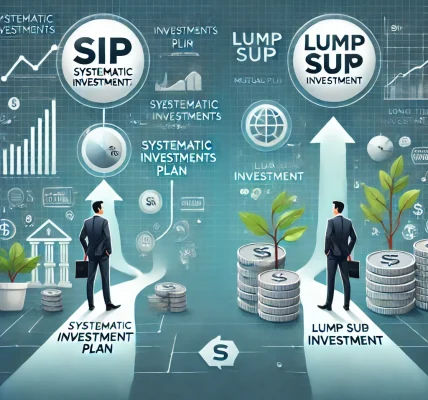Introduction
When investing in mutual funds, one of the most crucial decisions is choosing between active and passive funds. Both have unique advantages and drawbacks, and selecting the right one depends on your investment goals, risk tolerance, and market outlook.
This comprehensive guide will compare active and passive mutual funds, helping you determine which option suits your investment strategy.
Understanding Active and Passive Mutual Funds
What Are Active Mutual Funds?
Active mutual funds are professionally managed by fund managers who actively buy and sell securities to outperform a specific benchmark (such as the S&P 500 or Nifty 50). Fund managers use research, market trends, and forecasting to make investment decisions.
Key Features of Active Mutual Funds:
- Managed by experienced fund managers and research teams.
- Aim to outperform the market through active decision-making.
- Can invest in undervalued stocks and sectors with high growth potential.
- Usually have higher fees due to management costs and transaction expenses.
What Are Passive Mutual Funds?
Passive mutual funds, also known as index funds or exchange-traded funds (ETFs), aim to replicate the performance of a specific benchmark index. Instead of trying to outperform the market, these funds track and mirror an index’s composition.
Key Features of Passive Mutual Funds:
- Minimal involvement from fund managers.
- Lower expense ratios due to reduced transaction costs.
- No attempts to outperform the market; instead, they match its performance.
- Reduced risk of human errors or poor investment choices.
Comparing Active and Passive Mutual Funds
| Criteria | Active Mutual Funds | Passive Mutual Funds |
|---|---|---|
| Investment Strategy | Actively managed, aims to outperform the market | Tracks an index, aims to match the market performance |
| Risk Level | Higher due to market timing and stock selection | Lower as it follows a predefined index |
| Expense Ratio | Higher due to management and transaction costs | Lower since management is minimal |
| Potential Returns | Can be higher if fund manager makes successful bets | Typically lower but more stable in the long run |
| Fund Manager’s Role | Crucial in deciding investment strategies | Minimal role, follows the index automatically |
| Volatility | Higher due to active trading | Lower, as it mirrors an index |
| Investment Horizon | Suitable for investors with a higher risk appetite | Suitable for long-term, risk-averse investors |
| Best For | Investors who seek market-beating returns and can handle volatility | Investors who prefer low costs and consistent long-term returns |
Pros and Cons of Active and Passive Funds
Pros of Active Mutual Funds
✅ Potential for Higher Returns – Skilled fund managers can make well-timed investment decisions to beat the market. ✅ Flexibility – Fund managers can adjust portfolios based on market conditions. ✅ Better in Bear Markets – Active funds can shift to safer assets during downturns.
Cons of Active Mutual Funds
❌ Higher Fees – Management and transaction costs can reduce overall returns. ❌ Market Timing Risk – Even skilled managers can make poor investment choices. ❌ Greater Volatility – Frequent trading can lead to fluctuations in returns.
Pros of Passive Mutual Funds
✅ Lower Costs – Minimal management fees result in higher net returns. ✅ Transparent Strategy – Investors know exactly what they are investing in. ✅ Consistent Performance – Historically, passive funds have matched market growth over long periods.
Cons of Passive Mutual Funds
❌ No Flexibility – Passive funds cannot react to market conditions. ❌ Limited Potential for High Returns – They will never outperform the market. ❌ Downturns Affect Returns – If the index falls, the passive fund also falls.
Which One Should You Invest In?
Your choice between active and passive funds depends on several factors:
1. Investment Goals
- If you want higher returns and are willing to take risks, active mutual funds might be the right choice.
- If you prefer steady, predictable growth, passive funds are a better fit.
2. Risk Tolerance
- High-risk tolerance: Active funds can offer higher returns but are more volatile.
- Low-risk tolerance: Passive funds provide stability and lower volatility.
3. Investment Horizon
- Long-term investors (10+ years) may benefit from passive funds due to compounding and lower fees.
- Short- to medium-term investors might prefer active funds to capitalize on market opportunities.
4. Costs and Fees
- Passive funds are more cost-effective for investors looking to minimize expenses.
- Active funds charge higher fees, which can eat into profits over time.
5. Market Conditions
- In bullish markets, passive funds tend to perform well since they follow market trends.
- In volatile or bearish markets, active fund managers can make strategic shifts to minimize losses.
Real-Life Examples
When Active Funds Outperformed:
During market crashes (such as 2008 or 2020), some actively managed funds successfully minimized losses by shifting to safer assets.
When Passive Funds Outperformed:
Over the past decade, many index funds have outperformed actively managed funds due to lower costs and consistent compounding.
Hybrid Approach: Combining Active and Passive Investing
Many investors choose a hybrid approach by holding both active and passive funds. This strategy allows:
- Lower costs while still having exposure to high-growth assets through active funds.
- Market-matching stability through passive funds.
Example of a Balanced Portfolio:
- 50% in Passive Funds (Index Funds/ETFs) – Provides stable, long-term growth.
- 50% in Active Funds (Large/Mid-Cap Funds) – Offers the potential for market-beating returns.
Conclusion
Both active and passive mutual funds have their strengths and weaknesses. Active funds offer the chance to outperform the market but come with higher costs and risks. Passive funds provide lower costs and stable returns but lack flexibility.
The best approach depends on your investment goals, risk tolerance, and market outlook. A well-balanced portfolio combining both types of funds can help investors achieve optimal returns with manageable risk.
Final Recommendation
- New investors: Start with passive funds for long-term stability.
- Experienced investors: Consider a mix of active and passive funds based on market trends.
- Risk-averse investors: Passive funds are the safer choice.
- Aggressive investors: Active funds provide opportunities for higher gains.
Disclaimer: Mutual fund investments are subject to market risks. Past performance is not indicative of future results. Please consult a financial advisor before making any investment decisions.




